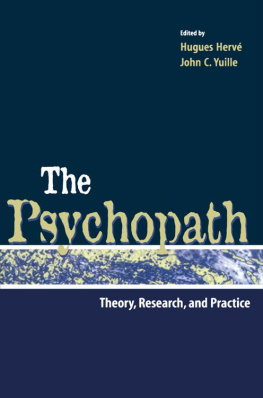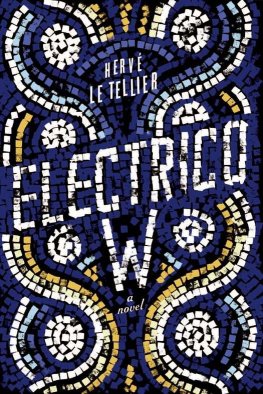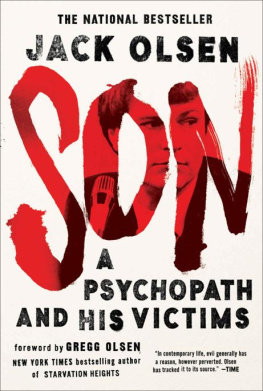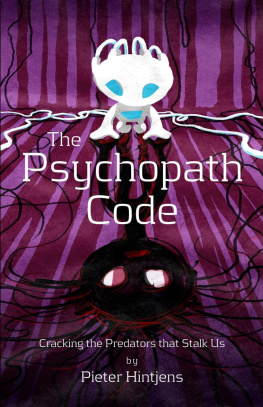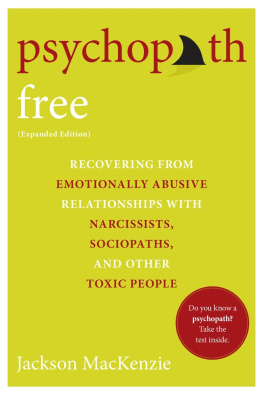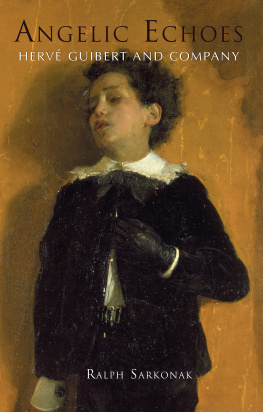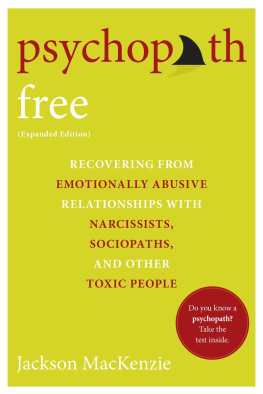Hugues Hervé - The Psychopath
Here you can read online Hugues Hervé - The Psychopath full text of the book (entire story) in english for free. Download pdf and epub, get meaning, cover and reviews about this ebook. year: 2017, publisher: Taylor and Francis, genre: Home and family. Description of the work, (preface) as well as reviews are available. Best literature library LitArk.com created for fans of good reading and offers a wide selection of genres:
Romance novel
Science fiction
Adventure
Detective
Science
History
Home and family
Prose
Art
Politics
Computer
Non-fiction
Religion
Business
Children
Humor
Choose a favorite category and find really read worthwhile books. Enjoy immersion in the world of imagination, feel the emotions of the characters or learn something new for yourself, make an fascinating discovery.
- Book:The Psychopath
- Author:
- Publisher:Taylor and Francis
- Genre:
- Year:2017
- Rating:5 / 5
- Favourites:Add to favourites
- Your mark:
- 100
- 1
- 2
- 3
- 4
- 5
The Psychopath: summary, description and annotation
We offer to read an annotation, description, summary or preface (depends on what the author of the book "The Psychopath" wrote himself). If you haven't found the necessary information about the book — write in the comments, we will try to find it.
The Psychopath — read online for free the complete book (whole text) full work
Below is the text of the book, divided by pages. System saving the place of the last page read, allows you to conveniently read the book "The Psychopath" online for free, without having to search again every time where you left off. Put a bookmark, and you can go to the page where you finished reading at any time.
Font size:
Interval:
Bookmark:

Theory, Research, and Practice
Theory, Research, and Practice
Edited by
Hugues Herv
Forensic Psychiatric Hospital
John C. Yuille
University of British Columbia
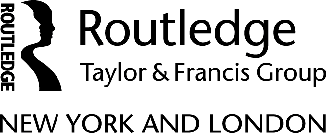
First published by Lawrence Erlbaum Associates, Inc., Publishers
10 Industrial Avenue
Mahwah, New Jersey 07430
This edition published 2012 by Routledge
| Routledge Taylor & Francis Group 711 Third Avenue New York, NY 10017 | Routledge Taylor & Francis Group 2 Park Square Milton Park, Abingdon Oxfordshire OX14 4RN |
2007 by Taylor & Francis Group, LLC
Routledge is an imprint of Taylor & Francis Group
15 14 13 12 11 10 9 8 7 6 5 4
International Standard Book Number-13: 978-0-8058-6079-5 (Softcover)
Except as permitted by U.S. Copyright Law, no part of this book may be reprinted, reproduced, transmitted, or utilized in any form by any electronic, mechanical, or other means, now known or hereafter invented, including photocopying, microfilming, and recording, or in any information storage or retrieval system, without written permission from the publishers.
Trademark Notice: Product or corporate names may be trademarks or registered trademarks, and are used only for identification and explanation without intent to infringe.
Library of Congress Cataloging-in-Publication Data
Catalog record is available from the Library of Congress
Visit the Taylor & Francis Web site at
http://www.taylorandfrancis.com
and the Routledge Web site at
http://www.routledgementalhealth.com
This volume is dedicated to the memory of Cheryl Wynne Hare, whose life and death touched all who knew and loved her.
Robert D. Hare
Hugues Herv
Grant T. Harris and Marnie E. Rice
Craig S. Neumann, David S. Kosson, and Randy T. Salekin
Daniel M. Bolt
James F. Hemphill
Joseph P. Newman, Chad A. Brinkley, Amanda R. Lorenz, Kristina D. Hiatt, and Donal G. MacCoon
Christopher J. Patrick
Catherine M. Herba, Sheilagh Hodgins, Nigel Blackwood, Veena Kumari, Kris H. Naudts, and Mary Phillips
Steve Porter and Sasha Porter
Mary Ellen OToole
Alicia Spidel, Gina Vincent, Matthew T. Huss, Jason Winters, Lindsey Thomas, and Don Dutton
Paul J. Frick
Adelle Forth and Angela S. Book
Rebecca Jackson and Henry Richards
Paul Babiak
Hugues Herv
Stephen C. P. Wong and Grant Burt
Barry S. Cooper and John C. Yuille
David Thornton and Linda Blud
In 2000, John and I had the honor of organizing a festschrift for (a tribute to) Dr. Robert D. Hare in light of his retirement (at least on paper) from academia. To celebrate this momentous occasion, we invited experts from all over the world, all doing research on some aspect of psychopathy. Our aim was to have not only renowned scholars but individuals who, in one way or another, had been influenced by Dr. Hare, either directly via supervision and collaborative enterprises or indirectly by the enormous contribution that Dr. Hare had made to this area of study throughout his illustrious career. Not surprisingly, a list of speakers was not difficult to find. In fact, it was hard to think of any expert who had, to one degree or another, not been influenced by Dr. Hare and his research. Moreover, invitations were, almost without exception, enthusiastically accepted.
In light of the response we received, the festschrift quickly evolved into a conference which was held in October of 2000 and attended by many. The Hare Psychopath: Past, Present, and Future was, by all accounts, a great success. In light of the quality and breadth of topics covered, as well as the many other topics informally discussed, it became apparent that it was time for an edited volume that reflected the changing face of psychopathy theory, research, and practice. This was the impetus for this book. Most of the conference presenters eagerly agreed to author chapters; others regrettably could not. To ensure that topics of importance were addressed, we expanded our list of contributors beyond conference presenters. As a result, this volume consists of scholarly pieces from leading figures in the field. We are most appreciative of their involvement.
This book is intended for academics, researchers, theorists, practitioners, lawyers, judges, law enforcement personnel, students, and other professionals interested in or working within forensic psychology. In addition, this text is of interest to other mental health law professionals who study and/or treat psychopathology (e.g., criminologist, sociologist, etc.), especially those interested in personality disorders. Given its depth and scope, it will make interesting supplementary reading for graduate students within programs specializing in Forensic Psychology and Criminology.
We have organized this volume to parallel the manner in which we believe ones understanding of psychopathy should evolve. The book begins with a historical view of psychopathy, then examines measurement issues, followed by etiological theories and practical considerations. The chapters have been grouped to reflect this organization.
In light of psychopaths socially destructive nature, the study of psychopathy is of critical importance. Fortunately, this area of enquiry has come a long way and promises to evolve into new and exciting arenas. Dr. Hare introduces this volume by discussing the current state of psychopathy research, highlighting its advancements, potential pitfalls or impediments, and future trajectory. The remaining chapters draw attention to these various topics.
In , Dr. Herv discuss the evolution of the construct throughout the ages, following which Drs. Harris and Rice provide a specific example of how the construct evolved within a correctional treatment facility.
In , the implications of statistical advances in recent years for refining our understanding of psychopathy are discussed. The chapters by Drs. Neumann, Kosson, and Salekin and by Dr. Bolt provide new insights into Item Response Theory and Factor Analysis, highlighting its implication for the construct of psychopathy, as defined by the PCL-R. Dr. Hemphill then tackles methodological issues related to psychopathy-related risk research.
In , three models addressing the nature and etiology of psychopathy are described. Dr. Newman and his colleagues outline a neurocognitive theory in which attention-related deficits play a central role. Dr. Patrick describes his emotion-based theory of psychopathy. Finally, Dr. Herba and her colleagues review neurobiological research, with a specific focus on emotion processing. By contrasting these three models within one volume, we hope to allow readers to easily compare each theorys strengths and weaknesses.
In , the socially destructive aspects of the disorder are reviewed. Dr. and Mrs. Porter focus specifically on the nature of psychopathic violence. The implication for Violent Crime Scene Analysis is then discussed by Dr. OToole. This section concludes with Ms. Spidel and her colleagues discussing the emerging research in the area of domestic violence.
In , the generalization of the construct of psychopathy across populations and settings is reviewed. The construct of psychopathy, as defined by the Hare PCL-R, was initially validated on incarcerated male offenders. Given the implications of this line of research, a concerted effort was made to see if this construct applies to other arenas. Dr. Frick reviews how the construct of psychopathy can be useful to understand behaviorally challenging children. In a similar vein, Drs. Forth and Book review the research on psychopathy in adolescent offenders, highlighting its strengths and weaknesses. Drs. Jackson and Richards review the empirical and clinical implications of psychopa-thy for women offenders. This section concludes with Dr. Babiaks research and experience with psychopaths in the work place. Each chapter focuses on measurement issues, practical implications, and ethical considerations.
Font size:
Interval:
Bookmark:
Similar books «The Psychopath»
Look at similar books to The Psychopath. We have selected literature similar in name and meaning in the hope of providing readers with more options to find new, interesting, not yet read works.
Discussion, reviews of the book The Psychopath and just readers' own opinions. Leave your comments, write what you think about the work, its meaning or the main characters. Specify what exactly you liked and what you didn't like, and why you think so.

